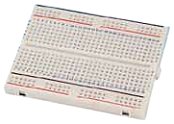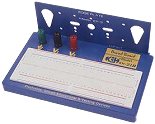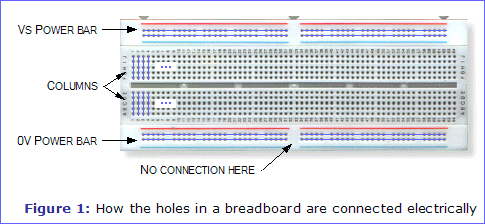Breadboard
By Tim Surtell
A breadboard, also known as a plugblock, is a plastic unit that is used to create prototypes of your circuits when they are at the experimental stage. No soldering is required, so it is easy to move components around if you need to - the component leads are simply pushed into the holes in the breadboard.
| Related Articles | Stripboard |
The photos below show some of the breadboards that are available. Some incorporate terminal posts for power supplies and component plates to secure larger components like switches and variable resistors.


The piece of breadboard shown above left is a typical design. Boards of the this type can be placed side by side and joined together using the jig-saw-like lugs on the longer sides. Underneath the board is a self-adhesive pad. If you are planning on constructing a large circuit with several boards and lots of external components, it is worth using this feature to fix the breadboards to a surface such as a large, sturdy, plank of wood. The external components can also be fixed to this plank, making the whole thing self contained and easier to move around. Be aware though, that you probably won't be able to remove the breadboards from the plank later on without damaging them.
The breadboard is a matrix of holes spaced 0.1" apart - the standard spacing for the leads of electronic components. Underneath, the holes are electrically connected as shown by the lilac-coloured lines in figure 1. The main part of the board has two rows of columns consisting of five holes each. Between the rows there is no connection and the width of this gap is just right for the placement of integrated circuits (ICs, or microchips). Thus, when an IC is placed across the gap, there are four holes available for connections to each pin of the IC.
The two power supply bars (one at the top, one at the bottom) can be detached from the main part of the board if not needed. These consist of two rows each, each row having clumps of five holes. All holes on a row are electrically connected. Note though, that on a larger breadboard, like the one in figure 1, this will not be the case, and the electrical connection will be broken in the middle of each row.

Firstly, you should connect your power supply to the power bars. The Vs supply should always be connected to the top row of the breadboard, with 0V being connected to the bottom row. On boards like the one shown, this is suggested by the red and blue colour coding. If your circuit requires extra supply voltages, you can use the two spare rows on the power bars. When using a board like the one shown, don't forget to put some wire links across the middle of the power bars to bridge the gaps.
As previously mentioned, ICs should be placed between the two main rows so that their pin 1 is at the bottom left. Connect the power supply pins of each IC to the appropriate power bar using red wire for Vs and black wire for 0V.
The best type of wire to use with breadboard is single-core equipment wire since it is stiff and is easily pushed into the holes. If you don't fancy cutting and stripping all the wires you'll use, you could buy a Jump Wire Kit which contains wire links in assorted lengths and colours.
I find it helpful to colour-code wires connecting the various components of a circuit to tell me at-a-glance what type of signal a wire is carrying. The colour-code I use is shown below. I use it when designing digital circuits, so if you don't understand what it means, don't worry - just make up your own colour-code to fit the categories of signal used in your own circuits.
After working on your circuit, cover it over to keep the dust out. When storing a breadboard, put it back in its box or store it upside-down to keep the dust out. If you continually leave breadboard open to the air, over time the holes will fill with dust which could reduce the effectiveness of the connection between the wires and the breadboard. Believe me, this can be very frustrating when you can't figure out why your circuit won't work!
Article Information
Source: Electronics in Meccano - www.eleinmec.com
| First published in EiM: Issue 2 (January 1999)
Topic: Practical Matters |
Created: 17/03/2002 |
Last modified: 02/08/2007
Top of Page | Homepage | About | Search | Topics | Features | Circuits Shop | yourEiM |
© 1998 - 2024 Tim Surtell |